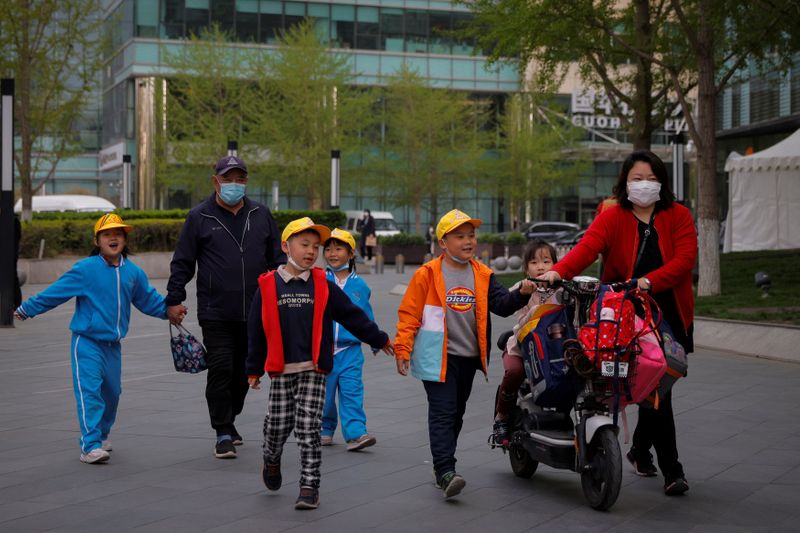BEIJING (Reuters) – China’s once-a-decade census is expected to show a further fall in the percentage of young people in its fast-aging population as high living costs and an aversion to having children among urban couples push China closer to a demographic crunch.
Policymakers are under pressure to come up with family-planning incentives and arrest a falling birth rate, with the world’s most populous country at risk of entering an irreversible population slide if effective measures are not found.
China is expected to release the results of its latest census, conducted in late 2020, in coming days. The proportion of elderly people in the population is believed to have risen, but more significant will be the data on its young.
In 2010, the proportion of the population aged 14 or younger plunged to 16.60% from 22.89% in 2000, an effect of a decades-old one-child policy. Citizens aged 60 and older accounted for 13.26%, up from about 10%.
The continuation of those trends will undermine China’s working-age population and weigh on productivity. A shrinking pool of working adults will also test its ability to pay and care for an aging nation.
In 2016, China scrapped the one-child policy in the hope of boosting the number of babies. It also set a target to increase its population to about 1.42 billion by 2020, from 1.34 billion in 2010.
But the birth rate has continued to decline.
That is in part because urban couples, despite parental pressure to have babies, value their independence and careers more than raising a family.
Yu Tao, 31, a Beijing-based product designer for a major tech firm, said he was reluctant to make the sacrifice in terms of time that he would have to if he and his wife had a baby.
As is, he usually gets home from work at midnight, at the earliest.
“I like my balance right now, how I balance between my work and personal life, and I don’t think I can still be in this good balance once I have a child,” Yu said.
IRREVERSIBLE SLIDE?
Yu and his wife have a combined income of more than 700,000 yuan ($106,888) a year but said they did not feel financially secure enough to have a child, even though they earn considerably more than an average household.
Annual urban per capita disposable income was 43,834 yuan in 2020 compared with 19,109 yuan in 2010, official data shows.
“We aren’t ready for a child both financially and mentally,” said Yu.
Rising living costs in big cities, a major source of babies because of their huge populations, have also put couples off children, particularly housing costs.
Among urban households, annual per capita spending on housing rose to 6,958 yuan in 2020 versus 1,332 yuan in 2010, according to official data, up more than five-fold.
“If the government simply allows people to have children without policy support, it is unlikely to have much impact,” said social and labour expert Liu Kaiming.
“In general, the case that people are reluctant to have children, or to have fewer, is irreversible.”
State media has been making increasingly dire predictions, saying the population may start to shrink in the next few years – a gloomier forecast than that of the United Nations, which foresees a population peak in 2030, then a decline.
In 2016, China set a 2020 target for its fertility rate to be about 1.8 children per woman, up from 1.5-1.6 in 2015.
If the rate falls below 1.5, many demographers say China is unlikely to ever get out of its so-called fertility trap.
Recent comments by the minister of civil affairs that the fertility rate had already crossed a “warning line” and the population had entered a critical period of transition went viral on social media.
($1 = 6.5489 Chinese yuan renminbi)
(Reporting by Ryan Woo; Additional reporting by Liangping Gao, Lusha Zhang and Beijing newsroom; Editing by Robert Birsel)



















